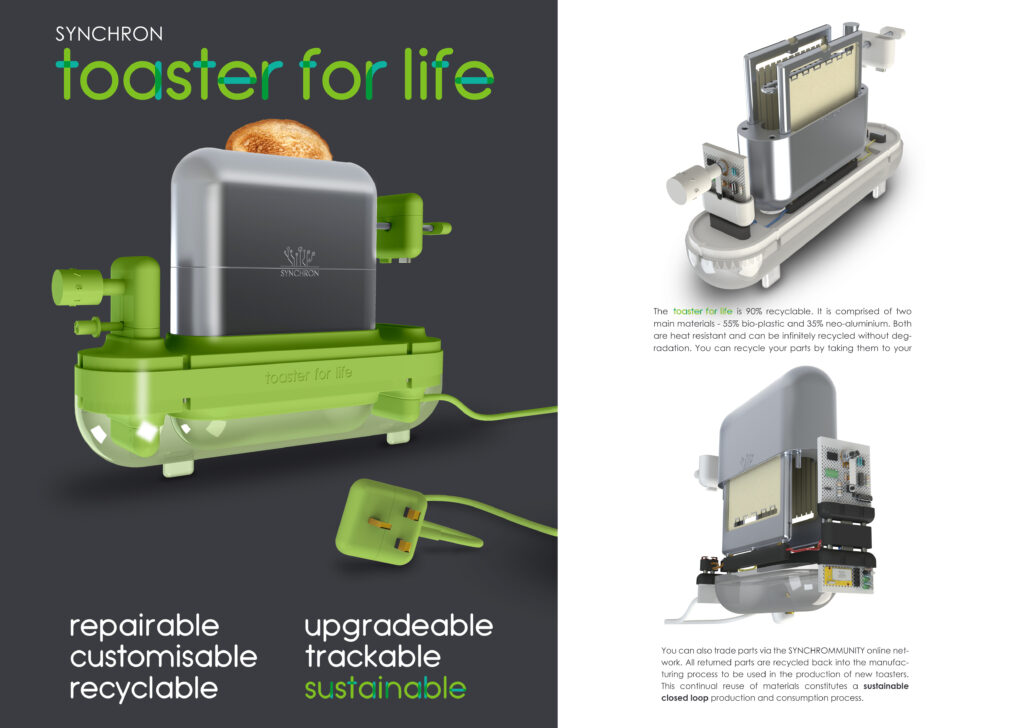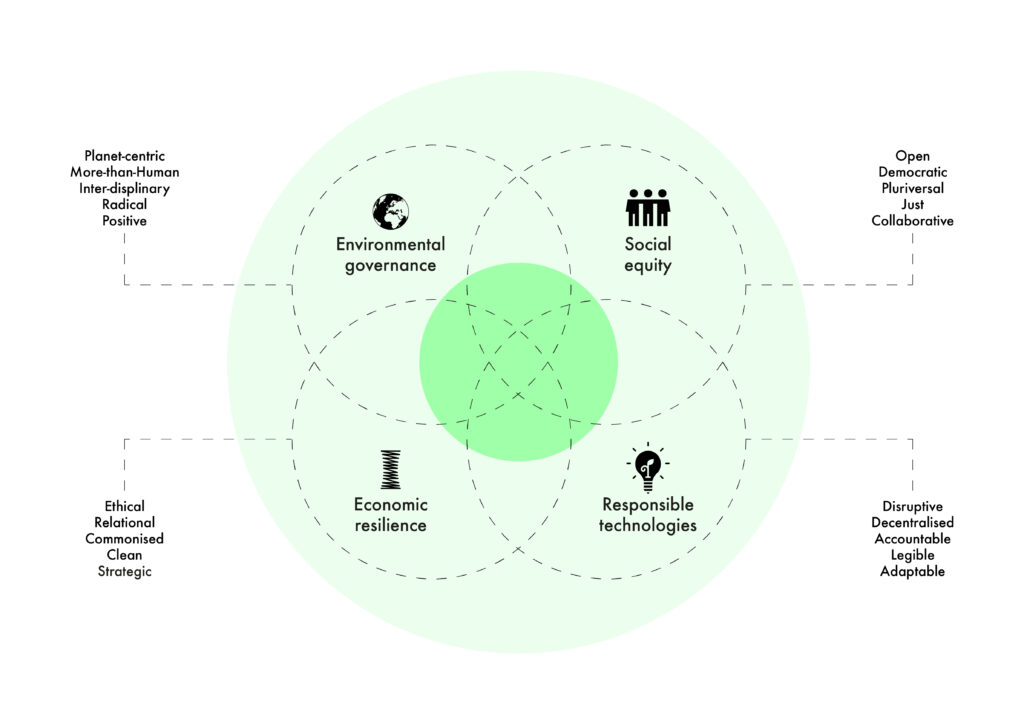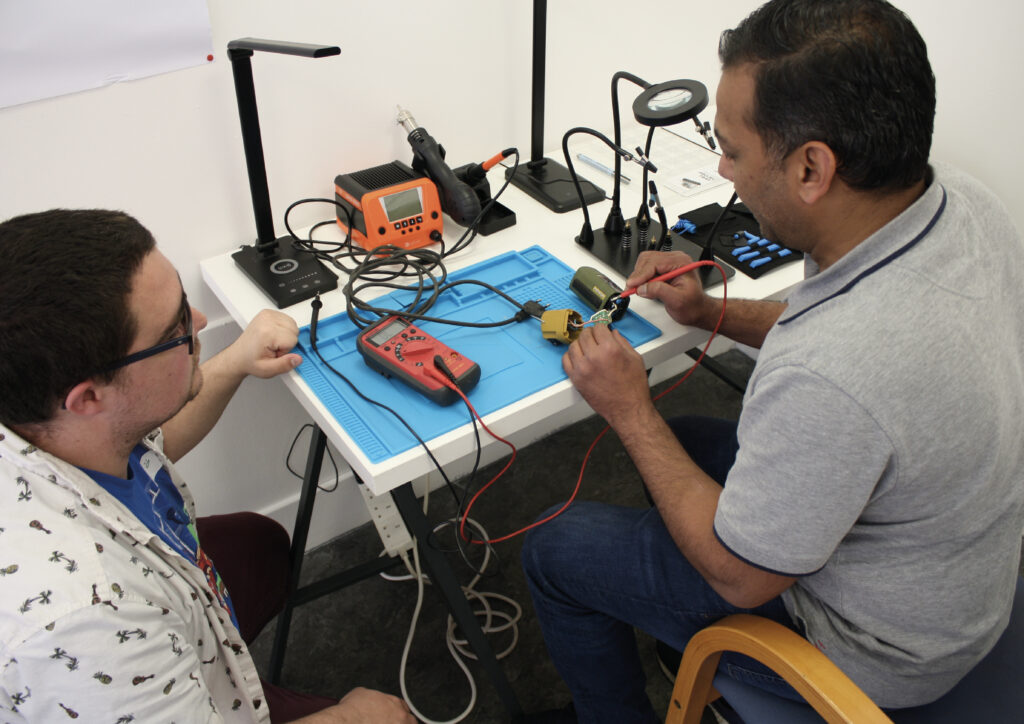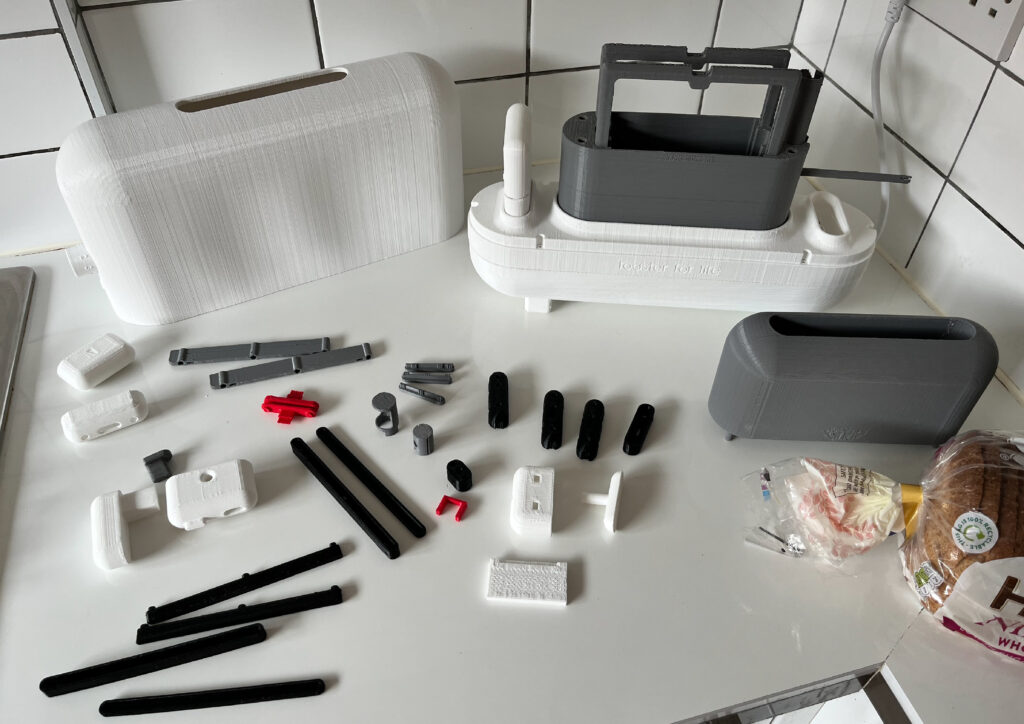
‘Make Do and Mend’ was a national awareness campaign which ran during WWII in Britain. As the war raged on and materials and resources became scarce, the purchase of new clothes was rationed. The country’s then Board of Trade and Ministry of Information strongly urged people to not create clothes waste by reimagining how to use their existing garments through acts of repair (British Library, n.d.). The recent introduction of the Right-to-Repair (R2R) across the EU and UK (European Commission, 2020; Conway, 2021) could be seen as a ‘Make Do and Mend’ strategy for today’s electronic devices.
At first glance, the R2R appears to provide citizens and communities with powers to start to redress late modernity’s penchant for planned obsolescence and electronic waste. Yet, the much-hyped legislation does not account for the repair of billions of networked or so-called ‘smart’ Internet of Things (IoT) devices. With doyens like Fairphone (2022) and Framework laptops (2022) being the exception, rather than the rule, most internet-connected products are inherently unsustainable – their hardware is not designed to enable effective repair nor reuse, and their software can easily become obsolete when it cannot support new updates (Stead & Coulton, 2022).
The current R2R legislation also allows Big Tech – the likes of Apple, Amazon, Microsoft, and Google – to maintain dominion when it comes to IoT product maintenance, rather than helping to foster innovative, more open, citizen-oriented cultures of repair. The firms still control replacement part supply chains and repair services for IoT (Peake & Vallauri, 2021). Given the UK’s political fealty to laissez-faire neo-liberal economics, it is unsurprising that there has also been no national Right-to-Repair awareness campaign, no government review of Big Tech’s repair hegemony, and, though admittedly more extreme, no rationing of the consumption of ‘smart’ devices. This is despite IoT’s damning e-waste and material scarcity credentials. In response to such inaction, The Repair Shop 2049 (RS2049) project was born.
A design research project, RS2049 has sought to begin to challenge the tech firm-controlled status quo by envisioning pathways for developing more open, community-led IoT repair in Blackburn, a post-industrial town in the North-West of the UK. Collaborating closely with The Making Rooms Blackburn, a public makerspace and creative hub for digital innovation, we are trying to empower ordinary citizens with the knowledge, tools, and confidence to increase IoT repair and reuse directly within their local community. In doing so, RS2049 contributes to the growing open repair movement which was spearheaded by groups including The Restart Project (2022), RepairEU (2022) and iFixit (2022), all of whom have worked tirelessly over the past decade or so to improve the longevity of electronic devices’ lifecycles.
Crucially, while the project shares DNA with existing interventions like repair cafés, the RS2049 vision looks beyond individual devices in order to innovate a new socio-technical ecosystem for IoT repair. We are collaborating with a wide variety of key stakeholders including makers/repairers, civic leaders, device end-users and manufacturing representatives. Drawing upon various work including Sovacool et al (2020) and Elkington’s (1997) notion of the Triple Bottom Line for Sustainability, Figure 1 depicts our emerging framework for sustainable and equitable socio-technical futures. Adopting a systemic approach like this is seen as increasingly critical to designing radical yet responsible socio-technical change (Ceschin & Gaziulusoy, 2016; Design Council, 2021). Shannon Mattern (2018) concurs, noting how, to manage care and repair of modern yet often disposable technologies, ‘maintenance has taken on new resonance as a theoretical framework, an ethos, a methodology, and a political cause.’

As part of our research, we have run a series of stakeholder workshops which have begun to reveal some of the drivers and opportunities for scaling up such practices and infrastructures but equally many barriers and risks. To provoke and inspire our participants to think about alternate repair futures for IoT, during our workshops we used speculative design techniques (Elsden et al, 2017; Coulton et al, 2017) including the installation of what we termed a Self-Service IoT Repair Station (Figure 2).

Our community-cultivated data has enabled the envisioning of a socio-technical imaginary for future IoT repair (Figure 3). It illustrates the strong desire for the urgent opening up of IoT repair practices, skills and technologies which could be made accessible by building channels and connections between multiple glocal stakeholders. Core to this vision are key agents of the open movement – Fab Labs and social enterprise like the RS2049 as well as more mindful manufacturers like Fairphone. Also significant is the constant flux in independence and interdependency between bottom up and top down stakeholders.

The end game of course, is for this imaginary to become a socio-technical reality. Achieving such a major transition might be considered a sisyphean endeavour, however. It has long been promised that we are on the cusp of a fourth Industrial Revolution or Industry 4.0, where the decentralisation of technologies could lead to a more sustainable and equitable paradigm known as Distributed Manufacturing (Srai et al, 2020). This future is yet to come to pass – and should it? Steven Jackson (2014), in his seminal essay Rethinking Repair, used the term broken world thinking to describe how, in his view, to effectively negotiate socio-technical change, we should take ‘erosion, breakdown, and decay, rather than novelty, growth, and progress, as our starting points.’ This position is echoed by The Maintainers group (2022) which counts Vinsel & Russell (2020), the authors of the acclaimed The Innovation Delusion, as members.
With its DIY aesthetic, Punk Rock was a revolt against the political inertia, social injustice and economic depression that paralysed late 1970s Britain. The movement enabled marginalised voices to be heard and kickstarted a cultural shift across the country. While the Sex Pistols were nihilistic when they cried there is ‘no future for me… no future for you’, the RS2049 project is more solarpunk in its aesthetic. Whether or not one buys into the notion of factories everywhere (Stokes, Parvin & Knight, 2016), the RS2049 embodies solarpunk’s optimism when it comes to transitioning towards sustainable and social change through responsible forms of technological innovation (Flynn, 2014; Williams, 2019). Toaster for Life (Figures 4 & 5) is a speculative design which seeks to manifest solarpunk’s reverie. By challenging today’s unsustainable IoT status quo, the design presents a vision for a mass-manufactured connected device that is also repairable and reusable through integrated emergent tech including open-source hardware/software, 3D printable modular parts and locally sourced biomaterials.

Like our imaginary (Figure 3), the Toaster for Life reflects the inherent complexity of solarpunk futures – specifically the tension that arises between bottom up and top down knowledge, tech and action. Coldicutt et al (2021) stress how bottom-up endeavours are ‘not always optimised to capture disparate weak signals [and] are often convened to deliberate on issues that can be observed or anticipated by those with traditional power.’ This tension, they contend, places limits on the potential for alternative ‘unofficial’ futures to open up. As we move forward, we hope that by listening to a broad spectrum of stakeholders, we can respond to weak signals and collectively challenge the current R2R legislation to co-design resilient IoT repair futures.
Communities across the globe emerging from the effects of the Covid-19 pandemic are coming to terms with issues comparable with the 70s Punk era. Today, however, we also sit in the long shadow of a deepening climate crisis. It is more important than ever then that we start to critically, creatively and positively reimagine, not only our unsustainable relationships with everyday goods and services, but the wider sustainability of the social, technological, economic and environmental systems within which we all co-exist. This way we can begin to truly mobilise the solarpunk aesthetic.
The Repair Shop 2049 opening for business…soon.
About the Authors
Michael Stead is Lecturer in Sustainable Design Futures at Lancaster University’s design lab ImaginationLancaster. He explores the socio-technical implications that new technologies pose for achieving sustainability goals like the Circular Economy and Net Zero 2050.
Tom Macpherson-Pope is Director of The Making Rooms, Blackburn’s community makerspace and creative digital fabrication hub. He has an educational electronics background and was part of the team that created CodeBug.
Paul Coulton is Chair of Speculative and Game Design at ImaginationLancaster. He uses a Research through Design approach to explore technology development with consideration to the cultural landscape in which they may be deployed.
References
British Library. (n.d.) Make Do and Mend 1943. https://www.bl.uk/learning/timeline/large106365.html
Ceschin, F., & Gaziulusoy, I. (2016). Design for Sustainability: An Evolutionary Review, in Lloyd, P. and Bohemia, E. (eds.), Future Focused Thinking – DRS International Conference 2016, 27 – 30 June, Brighton, United Kingdom. https://doi.org/10.21606/drs.2016.59
Choong, Y.Y.C., Tan, H.W., Patel, D.C., Choong, W.T. N., Chen, C-H., Low, H. Y., Tan, M. J., Patel, C. D., & Chua, C. K. (2020). The Global Rise of 3D Printing During The COVID-19 Pandemic. Nature Reviews Materials, 5, 637–639.https://doi.org/10.1038/s41578-020-00234-3
Coldicutt, R., Williams, A., & Barron, D. (2021). A Constellation of Possible Futures: The Civil Society Observatory Discovery Report. London: Careful Industries http://careful.industries/foresight-observatory/discovery-report
Conway, L. (2021). The Right to Repair Regulations, Research Briefing Number 9302, House of Commons Library. https://researchbriefings.files.parliament.uk/documents/CBP-9302/CBP-9302.pdf
Coulton, P., Lindley, J.G., Sturdee, M., & Stead, M. (2017). Design Fiction As World Building. In
Proceedings of Research through Design Conference (RTD) 2017, Edinburgh, UK.
Davies, R. (2020). Dyson will not supply ventilators to NHS to treat Covid-19. https://www.theguardian.com/world/2020/apr/24/dyson-will-not-supply-ventilators-to-nhs-to-treat-covid-19
Design Council. (2021). Beyond Net Zero: A Systemic Design Approach. https://www.designcouncil.org.uk/fileadmin/uploads/dc/Documents/Beyond%2520Net%2520Zero%2520-%2520A%2520Systemic%2520Design%2520Approach.pdf
Vinsel, L., & Russell, A.L. (2020). The Innovation Delusion: How Our Obsession with the New Has Disrupted the Work That Matters Most. Currency.
Doctorow, C. (2009). Makers. HarperCollins UK/Voyager.
Elkington, J. (1997). Cannibals With Forks: The Triple Bottom Line of 21st Century Business.
Oxford: Capstone.
Elsden, C., Chatting, D., Durrant, A.C., Garbett, A, Nissen, B., Vines, J and Kirk, D.S. (2017).
On Speculative Enactments,’ in Proceedings of the 2017 CHI Conference on Human Factors in Computing Systems (CHI ’17), New York, ACM, 5386-5399.
European Commission. (2020). Circular Economy Action Plan. https://ec.europa.eu/environment/circular-economy/pdf /new_circular_economy_action_plan.pdf
Fairphone. (2022). https://www.fairphone.com/en/
Flynn, A. (2014). Solarpunk: Notes Toward A Manifesto. https://hieroglyph.asu.edu/2014/09/solarpunk-notes-toward-a-manifesto/
Framework. (2022). https://frame.work/gb/en
Jackson, S. J. (2014). Rethinking Repair. In T. Gillespie, P. J. Boczkowski, & K. A. Foot (Eds.), Media Technologies (pp. 221–240). MIT Press. https://doi.org/10.7551/mitpress/9780262525374.003.0011
iFixit. (2022). https://www.ifixit.com
Mattern, S. (2018). ‘Maintenance & Care’. https://doi.org/10.22269/181120
Peake, L., & Vallauri, U. (2021). The UK’s New ‘Right to Repair’ Is Not A Right to Repair. Inside Track. https://greenallianceblog.org.uk/2021/07/06/the-uks-new-right-to-repair-is-not-a-right-to-repair/
RepairEU. (2022). https://repair.eu
Restart Project. (2022). https://therestartproject.org
Sovacool, B.K., Bergman, N., Hopkins, D., Jenkins, K.E.H., Hielscher, S., Goldthau, A., & Brossmann, B. (2020). Imagining Sustainable Energy & Mobility Transitions: Valence, Temporality, & Radicalism in 38 Visions of A Low-Carbon Future. Social Studies of Science. 2020;50(4):642-679. DOI: 10.1177/0306312720915283
Srai, J.S., Graham, G., Hennelly, P., Phillips, W., Kapletia, D. and Lorentz, H. (2020). Distributed Manufacturing: A New Form of Localised Production? International Journal of Operations & Production Management, Vol. 40 No. 6, pp. 697-727. https://doi.org/10.1108/IJOPM-08-2019-0600
Stead, M., and Coulton, P. (2022). A More-than-Human Right-to-Repair, in Lockton, D., Lloyd, P., Lenzi, S. (eds.), DRS2022: Bilbao, 25 June – 3 July, Bilbao, Spain. https://doi.org/10.21606/drs.2022.718
Stokes, M., Parvin, A., Knight, H. (2016). The Factory Everywhere: The Present and Future of Distributed Manufacturing. https://www.nesta.org.uk/blog/the-factory-everywhere-the-present-and-future-of-distributed-manufacturing/
The Maintainers. (2022). https://themaintainers.org
Williams, R. (2019). This Shining Confluence of Magic and Technology’: Solarpunk, Energy Imaginaries, and the Infrastructures of Solarity. Open Library of Humanities 5(1), p.60. https://doi.org/10.16995/olh.329

